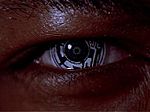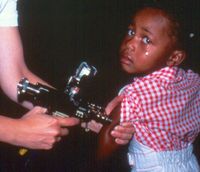- Medicine in Star Trek
-
Medicine in Star Trek refers to the medical technologies, procedures and conditions as seen in the Star Trek fictional universe.
Contents
Medical technology
Since the Star Trek fictional universe takes place roughly two or three centuries in our future, medical technology is portrayed as having grown to be far more sophisticated and advanced than current technology. When confronted with medical technology from older time periods, the character often react apprehensively or skeptically to the relatively outdated modern procedues. For example, when visiting a hospital in the 1980s in Star Trek IV: The Voyage Home, Dr. McCoy (played by DeForest Kelley) shows disdain for his 20th century counterparts and compares their procedures to the Dark Ages and the Spanish Inquisition.[1]
VISOR
Main article: VISORIn the series Star Trek: The Next Generation, the character Geordi La Forge (played by LeVar Burton) wears a piece of technology called a VISOR that allows him to "see" despite being blind from birth by directly sending the information into his brain. The device also gave him the ability to see in the electromagnetic and infrared spectrums. The VISOR was used as a plot device throughout multiple episodes, including one where the VISOR is used to brainwash La Forge[2] and one where emanations from the VISOR caused the character Worf to shift between parallel universes.[3]. Finally, in the movie Star Trek Generations, a group of Klingons used the VISOR to transmit the shield frequencies of the U.S.S. Enterprise-D to their ship, which allowed them to fatally cripple the Enterprise-D before they were destroyed.[4] When La Forge is next seen, in the movie Star Trek: First Contact, he no longer wears his VISOR in lieu of the more innocuous-looking ocular implants.[5]
The underlying mechanics of the VISOR (the transmission of images directly into the brain to overcome blindness) has been developed in the real world, albeit not as precisely as seen in Star Trek. In 2005, a team of medical researchers at Stanford University used a combination of microchip implants behind mice retinas and goggles equipped with LED readouts and a small camera to partially restore sight enough so that the mice could distinguish sets of black and white patterns.[6] In 2006, a woman who lost her sight in a car accident had a similar procedure performed on her in Portugal which gave her the ability to see object outlines and differences in light.[7]
Hypospray
Main article: HyposprayThe hypospray has been featured in every Star Trek series as a tool used to give injections of medications. It has been shown in the series to be able to deliver injections through clothing, and does not carry any risk of cross-contamination as opposed to modern hypodermic needles.[8] The concept of the hypospray was developed when producers on the original Star Trek series discovered that NBC's broadcast standards and practices prohibited the use of hypodermic syringes to inject medications; the needleless hypospray sidestepped this issue.[9]
The hypospray does have a modern counterpart called a jet injector, invented four years before the first Star Trek series debuted. It uses compressed air to inject the medication through the skin. However, unlike the hypospray,[citation needed] it carries the risk of cross-contamination, which has led to the jet injector falling into disuse.
Recently, the U.S. Food and Drug Administration approved a device which uses ultrasonic waves to open pores on the skin, allowing the injection liquid to enter the bloodstream without the use of needles.[10]
References
- ^ Star Trek IV: The Voyage Home
- ^ TNG The Mind's Eye
- ^ TNG Parallels
- ^ Star Trek Generations
- ^ Star Trek: First Contact
- ^ "Stanford physicists and eye doctors to design a "Bionic Eye".". WorldHealth.net. March 31, 2005. Archived from the original on 2007-09-27. http://web.archive.org/web/20070927215629/http://www.worldhealth.net/p/393,6765.html. Retrieved 2007-04-08.
- ^ "New device allows woman to see, even without eyes". News 14 Carolina. March 31, 2006. http://rdu.news14.com/content/top_stories/default.asp?ArID=82612. Retrieved 2007-03-27.
- ^ TNG Angel One
- ^ Whitfield, Stephen E., and Roddenberry, Gene, The Making of Star Trek, Ballantine Books, 1969, ASIN B000HYXX5S; reprinted by Titan Books Ltd., 1991, ISBN 1852863633
- ^ "Life Imitates Star Trek: SonoPrep Needle-less Injection". Gizmodo.com. September 28, 2004. http://gizmodo.com/archives/life-imitates-star-trek-sonoprep-needleless-injection-022206.php. Retrieved 2007-04-08.
Categories:- Star Trek
- Medicine and health in fiction
Wikimedia Foundation. 2010.


